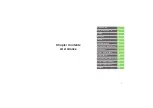
82
Advanced Operations
Dial Plan
The FLX UC 1000 and FLX UC 1500 support the use of a dial plan to reject
numbers that are not allowed to be dialed or auto-translate numbers to a
different format than the one entered. This is helpful for example when the
local dial plan requires a special digit to be dialed first to get an outbound line
(e.g. “9”), but the inbound call numbers do not reflect that. The dial plan
allows adding the leading “9” to a number stored in recent calls, allowing the
number to be re-dialed.
Dial Plan Syntax
Dial plans consist of a series of rules for dialing numbers. Rules are separated
by the “|” character.
The rules explain how input numbers represented by the digits and characters
that can be entered while dialing (0 - 9, *, #, +) will either be transformed into a
different string using the same digits and characters, or that it will be rejected.
To simplify defining the rules, placeholders and modifiers are used when
defining the possible dial strings.
'x' represents any one number ('0' - '9')
'[]' represents one of the numbers in the brackets
[389] means '3' or '8' or '9'
[3-9] means '3' or '4' or ... or '8' or '9'
'.' indicates any number of repetitions of the previous digit
01. matches "0", "01", "011", "0111", etc.
'<:>' represents a substitution '<' dialed sequence ':' substitute sequence '>'
<8:9> substitutes a dialed 8 with a 9.
<8:1650>xxxxxxx" matches "85551212" and dials "16505551212"
<9:>xxxxxxx removes a leading 9 ahead of a 7-digit number
<:604>xxxxxxx prepends 604 to all seven digit numbers
',' generates inter-sequence (dial) tones
















































